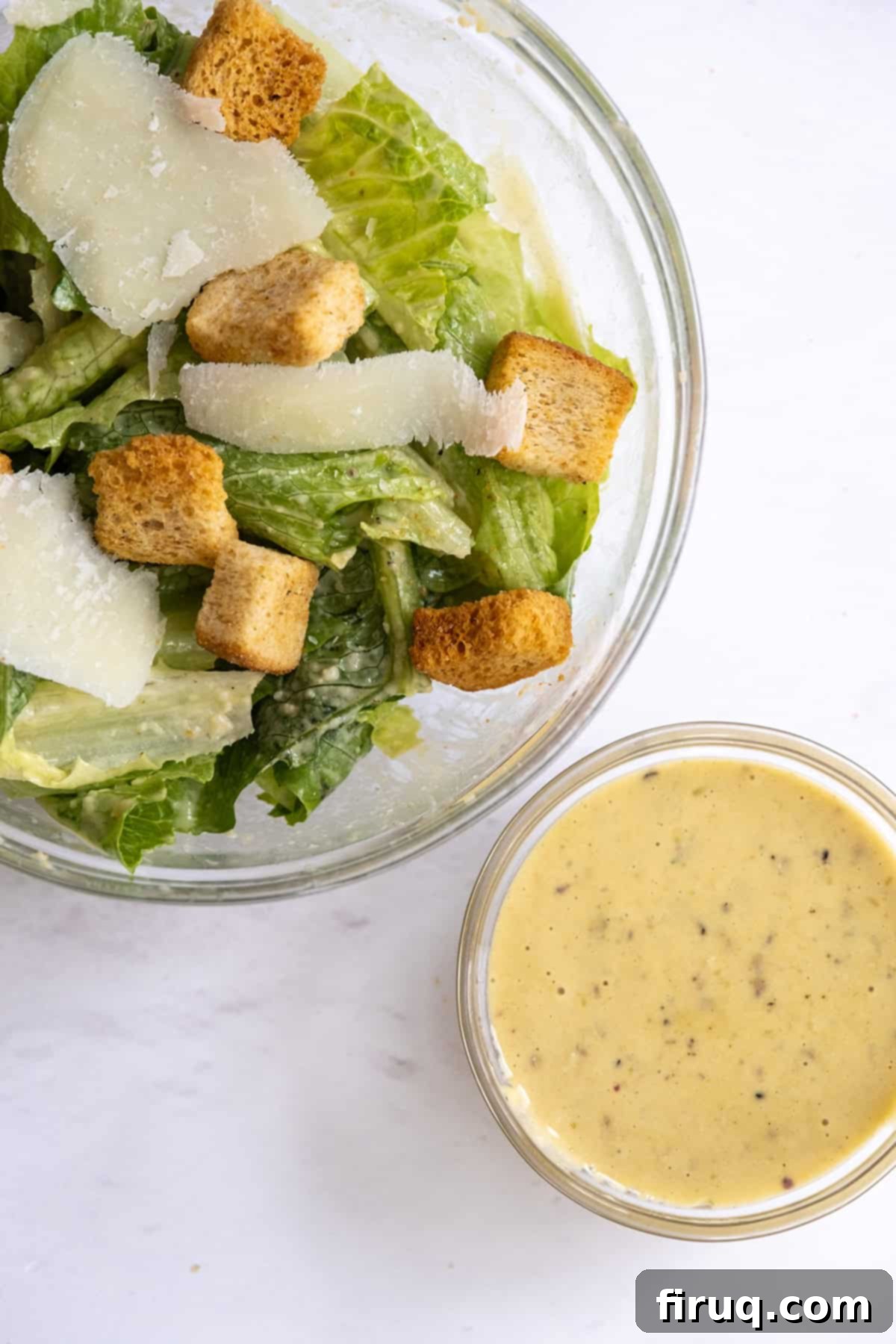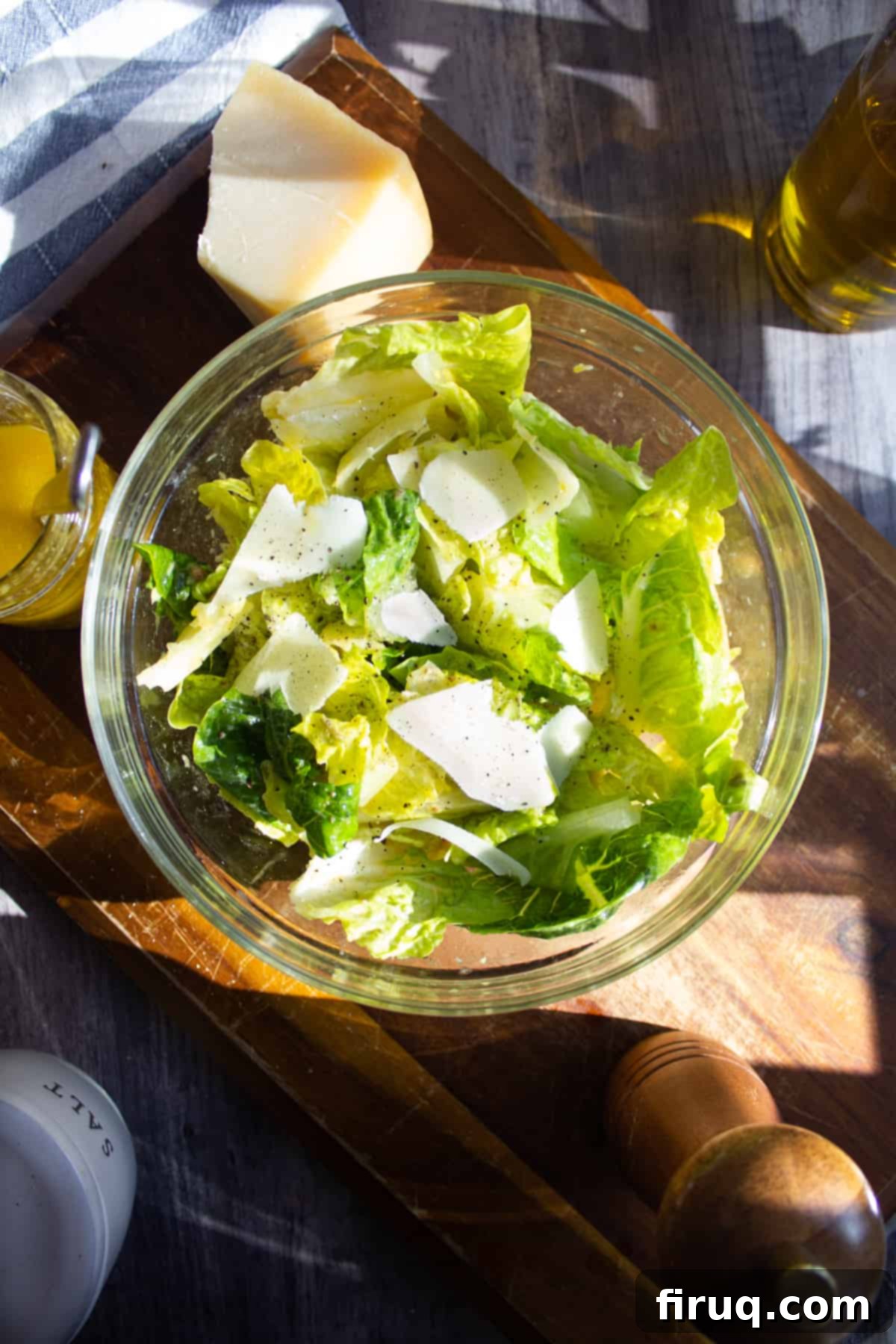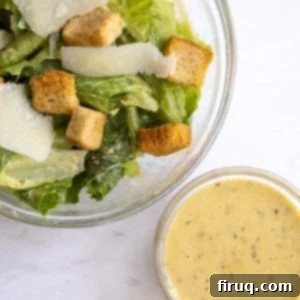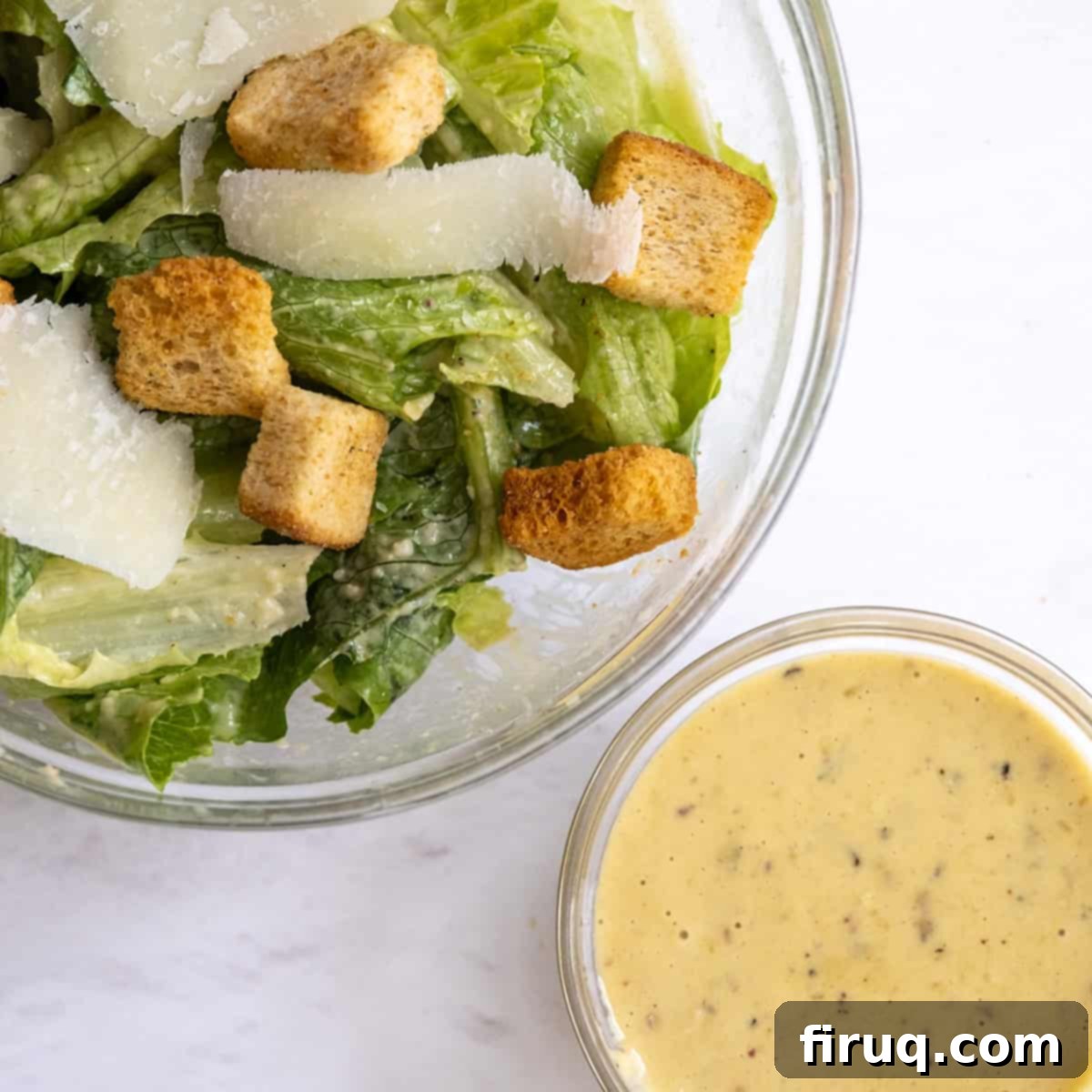The Ultimate Guide to Traditional Homemade Caesar Dressing: A Recipe Better Than Any Restaurant
Prepare to transform your everyday salads into extraordinary culinary experiences with this truly exceptional **Traditional Homemade Caesar Dressing**. Crafted with fresh, high-quality ingredients, this dressing offers a depth of flavor and a creamy texture that simply cannot be matched by store-bought alternatives. Imagine a Caesar salad so rich and authentic, topped with crisp romaine, flaky Parmesan, and homemade croutons, that it surpasses anything you’ve ever tasted in a restaurant. The best part? You can achieve this gourmet delight in **under 15 minutes** right in your own kitchen!

The Unbeatable Advantage of Homemade Dressings
Creating your own salad dressings from scratch is a culinary revelation, especially when it comes to a classic like Caesar. There’s a common misconception that homemade dressings are complicated or time-consuming, but this recipe proves otherwise. The joy of a truly fresh, vibrant dressing made with your own hands far surpasses the convenience of a store-bought bottle.
My personal journey into the world of homemade dressings began during my college years, largely out of financial necessity. At that time, spending extra money on bottled ranch or Italian dressing for a simple salad seemed illogical when olive oil and vinegar were readily available and far more cost-effective. What started as a budget-friendly alternative quickly evolved into a strong preference. I soon realized that commercial dressings often come laden with unnecessary added sugars, preservatives, and artificial ingredients that detract from the natural flavors of a fresh salad. It became clear that to enjoy a truly healthy and delicious salad, the dressing needed to be as wholesome as the greens it accompanied.
While I still hold a nostalgic appreciation for certain classic brands, my palate now favors the clean, authentic taste of homemade options. There’s something undeniably satisfying about knowing every single ingredient that goes into your food. Whether it’s a zesty lemon basil vinaigrette, a creamy Cilantro Lime Ranch, or this incredible **Traditional Caesar Dressing**, homemade versions consistently deliver superior flavor and nutritional benefits that my family and I have come to love. It’s a small, rewarding step that elevates everyday meals and enhances your overall cooking experience.
A Brief History of the Iconic Caesar Dressing
The origin of Caesar dressing is a fascinating tale, steeped in culinary legend. Contrary to popular belief, this world-renowned salad and its distinctive dressing were not named after a Roman emperor, but after an Italian-American restaurateur named Caesar Cardini. The most widely accepted story places its creation in Tijuana, Mexico, during a bustling Fourth of July weekend in 1924.
Faced with an unexpected rush of customers and a rapidly depleting pantry, Cardini famously improvised a salad using the ingredients he had on hand. This spontaneous creation, artfully tossed tableside, quickly captured the palates of his guests and became an instant sensation. Cardini’s original recipe, as recounted through various accounts, featured romaine lettuce, olive oil, raw egg, croutons, Parmesan cheese, Worcestershire sauce, garlic, and black pepper. It’s worth noting that pure anchovies were not explicitly part of the initial recipe; however, Worcestershire sauce itself contains anchovy extract, which provided the crucial umami depth that defines Caesar dressing’s characteristic flavor profile. This “traditional” recipe aims to replicate the essence of that simple yet profound original, celebrating how a handful of quality ingredients can combine to create a truly extraordinary taste.
The Magic Behind the Ingredients: What Makes a Traditional Caesar Dressing So Good?
Each component of this traditional Caesar dressing is carefully selected to contribute to its complex flavor, luxurious texture, and overall balance. Understanding the role of each ingredient will deepen your appreciation for this homemade masterpiece:
- Egg Yolks: These are the emulsification heroes of the dressing. The lecithin naturally present in egg yolks acts as an emulsifier, allowing the oil and other liquids to bind together smoothly, preventing separation and creating that signature creamy consistency. Using fresh, ideally organic, large egg yolks at room temperature is crucial for optimal results.
- Extra Virgin Olive Oil: As the primary fat component, the quality of your olive oil matters. Opt for a good quality, mild extra virgin olive oil. A mild flavor ensures that it complements rather than overwhelms the delicate balance of the other ingredients, creating a harmonious and well-rounded dressing.
- Anchovies (finely chopped): This is the secret ingredient that gives Caesar dressing its unmistakable savory punch and profound umami. While some may be hesitant, don’t skip them! When finely chopped and thoroughly incorporated, anchovies dissolve into the dressing, adding a deep, briny flavor without making the dressing taste overtly “fishy.” They are essential for authenticity.
- Dijon Mustard: Beyond its distinct tangy and slightly sharp flavor, Dijon mustard plays a vital role as a secondary emulsifier. It helps to stabilize the oil and egg yolk mixture, contributing to the dressing’s smooth consistency and preventing it from breaking. Its pungency also helps to cut through the richness of the oil.
- Worcestershire Sauce: This fermented condiment is a powerhouse of complex flavors—savory, sweet, and tangy with a hint of spice. Its inclusion further boosts the umami profile of the dressing, thanks in part to its anchovy content, adding a layer of depth and sophistication that is hard to replicate.
- Garlic (freshly minced): Fresh garlic is indispensable for that authentic, pungent kick found in a classic Caesar. Always use fresh cloves and mince them finely; garlic powder simply won’t deliver the same vibrant aroma or sharp, fresh taste.
- Fresh Lemon Juice: The bright, zesty acidity of freshly squeezed lemon juice is critical for balancing the richness of the olive oil and egg yolks. It adds a refreshing tang that enlivens all the other flavors and prevents the dressing from tasting heavy. Bottled lemon juice often contains preservatives and lacks the vibrant punch of fresh.
- Freshly Grated Parmesan Cheese: A key flavor enhancer, Parmesan adds a salty, nutty, and savory dimension while contributing to the dressing’s body and texture. Always grate your own cheese from a block; pre-grated varieties can contain anti-caking agents that affect flavor and consistency.
- Salt and Black Pepper: These fundamental seasonings are vital for tying all the distinct flavors together. Adjust them to your personal taste, but remember that anchovies and Parmesan are already salty. Freshly ground black pepper provides a more aromatic and robust spice than pre-ground.
Ingredients for Your Homemade Caesar Dressing
- 2 large egg yolks, at room temperature
- ¾ cup extra virgin olive oil, mild-flavored
- 4 anchovies, finely chopped (packed in oil, drained)
- ½ tbsp Dijon mustard, at room temperature
- 1 tbsp Worcestershire sauce
- 2 cloves garlic, freshly minced
- 1 tbsp fresh lemon juice
- ¾ cup freshly grated Parmesan cheese
- ¼ tsp salt, or to taste
- ½ tsp black pepper, freshly ground, or to taste
Whipping Together the Perfect Traditional Caesar Dressing

Making this creamy, flavorful traditional Caesar dressing at home is a rewarding experience. The process is surprisingly straightforward, yielding a superior result that will impress anyone who tastes it. Follow these detailed steps to achieve a perfectly emulsified and delicious dressing:
Step 1: The Emulsification Foundation. Begin by adding the 2 egg yolks to a clean, medium-sized mixing bowl. Using a whisk, beat the egg yolks vigorously and consistently for approximately 1 to 2 minutes. You’ll notice the yolks transform, becoming lighter in color and creamier in texture. This initial whisking helps to build a stable foundation for the emulsion. Next, with a very steady hand, start to **slowly drizzle** in the ¾ cup of extra virgin olive oil. It is crucial to add the oil in a thin, continuous stream, almost drop by drop at first, while simultaneously whisking the mixture vigorously and without interruption. As the dressing begins to thicken and takes on a creamy, opaque appearance, you can gradually increase the rate of the oil drizzle to a slightly faster, but still thin, stream. The key here is patience and continuous, energetic whisking to ensure the oil and egg yolks fully emulsify into a smooth, cohesive dressing. If you add the oil too quickly, the dressing may separate.
Step 2: Flavor Infusion. Once your dressing base is beautifully emulsified and thick, it’s time to incorporate the distinctive aromatic and savory elements. Add the finely chopped anchovies, the minced garlic, Worcestershire sauce, Dijon mustard, and the fresh lemon juice to the bowl. Stir all these ingredients together thoroughly until they are completely combined and the anchovies have largely dissolved into the creamy base. At this stage, you’ll begin to smell the classic, rich aroma of Caesar dressing developing.
Step 3: Finishing Touches and Serving. To complete your masterpiece, stir in the ¼ teaspoon of salt, ½ teaspoon of freshly ground black pepper, and the ¾ cup of freshly grated Parmesan cheese. Mix everything well until the cheese is evenly distributed throughout the dressing. Now, taste your dressing and adjust the seasonings as needed. You might find you prefer a touch more salt, a bolder kick of pepper, or an extra squeeze of lemon juice to suit your personal preference. Your homemade traditional Caesar dressing is now ready to serve! It is absolutely perfect tossed with crisp romaine lettuce, generously topped with crunchy Homemade Italian Parmesan Croutons, and finished with additional shaved Parmesan cheese for the ultimate, restaurant-quality Caesar salad experience.
Pro-Tips for a Foolproof Caesar Dressing
Achieving the perfect, creamy Caesar dressing is easier with a few insider tricks. These tips will help ensure your homemade creation is consistently delicious and perfectly emulsified:
- Whisking vs. Food Processor: While traditionalists might swear by hand whisking, a food processor or a blender can be your best friend for effortless emulsification. If hand whisking, you truly need to be patient, pouring the olive oil in an extra slow, thin stream while whisking vigorously and continuously. It takes practice and strong arm endurance! If you’re not confident in your whisking skills, or if your dressing starts to break, simply transfer the entire mixture to a food processor or blender. With the machine running on low, slowly drizzle in the olive oil through the feed tube until the dressing is thick, creamy, and perfectly emulsified. It’s a fantastic shortcut that guarantees success.
- Adjusting Consistency: A great Caesar dressing should be thick enough to cling to your lettuce leaves but still flow easily. If your dressing appears too thick for your liking, don’t worry. Simply add a tablespoon of cold water or a small amount of extra fresh lemon juice, one teaspoon at a time, and stir thoroughly until you achieve your desired pourable consistency. Be cautious not to add too much liquid at once, as it can thin out very quickly.
- Prioritize Fresh Ingredients: The vibrant flavor of this dressing hinges on the freshness of its components. Always use freshly minced garlic, freshly squeezed lemon juice (not from a bottle), and freshly grated Parmesan cheese from a block. The difference in taste and aroma compared to pre-packaged or dried alternatives is profound and truly makes a homemade Caesar dressing shine.
- Room Temperature for Success: For optimal emulsification, ensure that your egg yolks and Dijon mustard are at room temperature. Cold ingredients are more resistant to combining with oil, making it harder to achieve a stable emulsion. Taking them out of the fridge about 30 minutes before you start will make a significant difference.
- Taste and Adjust: Seasoning is a personal journey. Taste your dressing after adding the main ingredients but before the final salt and pepper. Remember that anchovies and Parmesan cheese contribute a considerable amount of salt, so start with the recommended amount and adjust to your preference. It’s much easier to add more seasoning than to correct an over-salted dressing.
Beyond the Salad Bowl: Creative Uses for Caesar Dressing
While this Traditional Homemade Caesar Dressing is undoubtedly the star of any Caesar salad, its rich, savory, and tangy profile makes it incredibly versatile. Don’t limit yourself to just salads; explore these exciting ways to incorporate this delicious dressing into other meals:
- Dynamic Marinade: This dressing makes an exceptional marinade for proteins. Use it to tenderize and infuse incredible flavor into chicken, shrimp, pork, or firm white fish before grilling, baking, or pan-frying. The lemon and garlic work wonders!
- Elevated Sandwich or Wrap Spread: Ditch the mundane mayonnaise! A generous smear of homemade Caesar dressing on your sandwiches, wraps, burgers, or even in pita bread adds an instant gourmet touch and a burst of savory flavor.
- Gourmet Vegetable Dip: Serve this creamy dressing alongside a platter of fresh, crunchy vegetables like carrot sticks, cucumber slices, bell pepper strips, or blanched broccoli florets. It transforms a simple veggie platter into a sophisticated appetizer.
- Unique Potato Salad or Coleslaw: Give your classic side dishes a memorable twist. Replace some or all of the mayonnaise in your potato salad or coleslaw recipe with this Caesar dressing for a bold and unexpected flavor profile.
- Flavor Booster for Roasted Vegetables: After roasting your favorite vegetables (think asparagus, Brussels sprouts, broccoli, or potatoes), drizzle a little Caesar dressing over them while they’re still warm. The heat helps the flavors meld, creating a deliciously savory side dish.
Storage and Shelf Life of Homemade Caesar Dressing
Because this traditional Caesar dressing is made with raw egg yolks, proper storage is crucial to maintain its freshness and safety. Once prepared, transfer the dressing immediately into an airtight container or a glass jar with a tight-fitting lid. Store it promptly in the refrigerator. For the best quality and safety, your homemade Caesar dressing should be consumed within 3 to 5 days. It is not recommended to freeze this dressing, as the emulsion may break upon thawing. Before each use, give the container a good shake or stir, as some slight natural separation of ingredients can occur in the fridge.
This recipe for Traditional Homemade Caesar Dressing is truly one of the easiest and most impactful additions you can make to your culinary repertoire. While it does require a little more love and effort than simply reaching for a mass-produced bottle, the unparalleled depth of flavor and the immense satisfaction of creating something so profoundly delicious from scratch are incredibly rewarding. You won’t just experience a generic “caesar” flavor; you’ll savor a vibrant symphony of fresh, perfectly balanced ingredients that sing on your palate.
Do not “sleep on” this incredible homemade Caesar dressing. Take that small step of extra effort and try this recipe today. We are confident that you and your loved ones will be absolutely delighted!
For more quick and inspiring instructional videos, be sure to follow us on Instagram @vindelgiudice or Tiktok @alwaysfromscratch. Happy cooking!
📖 Recipe

Traditional Caesar Dressing
Vincent DelGiudice
Pin Recipe
Equipment
-
1 food processor you could use a whisk or blender instead
-
1 medium bowl
-
1 whisk
Ingredients
- 2 large egg yolks (at room temperature)
- ¾ cup extra virgin olive oil (mild-flavored)
- 4 anchovies, finely chopped (packed in oil, drained)
- ½ tablespoon Dijon mustard (at room temperature)
- 1 tablespoon Worcestershire sauce
- 2 cloves garlic, freshly minced
- 1 tbsp fresh lemon juice
- ¾ cup freshly grated Parmesan cheese
- ¼ teaspoon salt (or to taste)
- ½ teaspoon black pepper (freshly ground, or to taste)
Instructions
-
In a medium bowl, add the 2 egg yolks. Whisk vigorously and consistently for 1-2 minutes until the yolks are creamy and light in color. Alternatively, if using a food processor, add the yolks and pulse until creamy.
-
For whisking: Slowly drizzle in the ¾ cup of olive oil, a few drops at a time initially, while continuously whisking energetically. As the mixture thickens and emulsifies, you can increase the oil flow to a thin, steady stream. Continue whisking until the dressing is thick and creamy. For food processor: With the processor running on low speed, slowly drizzle the ¾ cup of olive oil through the feed tube until the mixture is thick and emulsified.
-
Stir or process in the finely chopped anchovies, minced garlic, Worcestershire sauce, Dijon mustard, and fresh lemon juice until completely combined and fragrant.
-
Finally, whisk or pulse in the freshly grated Parmesan cheese, salt, and black pepper until well incorporated. Taste and adjust seasonings as desired. Serve immediately with crisp romaine lettuce, Homemade Italian Parmesan Croutons, and extra shaved Parmesan.
Notes
- Emulsification is Key: Whether whisking by hand or using a food processor, the slow addition of olive oil while continuously mixing is paramount for achieving a smooth, creamy, and stable emulsion. Patience is a virtue here!
- Raw Eggs Safety: While traditional, raw eggs carry a small risk of salmonella. If you are concerned, consider using pasteurized egg yolks or a high-quality mayonnaise as a base (though this would deviate slightly from a strictly traditional recipe).
- Storage: Store homemade Caesar dressing in an airtight container in the refrigerator for 3-5 days. It is not recommended to freeze this dressing as the emulsion may break upon thawing.
- Adjusting Thickness: If the dressing is too thick, add a teaspoon of cold water or a little more lemon juice until it reaches your preferred consistency.
- Vegan/Egg-Free Option: For an egg-free version, a good quality vegan mayonnaise can be used as a base, then incorporating the remaining ingredients. This will alter the traditional texture slightly but still yield a delicious dressing.
Nutrition
Carbohydrates: 3g
Protein: 5g
Fat: 32g
Saturated Fat: 6g
Polyunsaturated Fat: 3g
Monounsaturated Fat: 21g
Cholesterol: 76mg
Sodium: 764mg
Potassium: 61mg
Fiber: 0.1g
Sugar: 0.4g
Vitamin A: 198IU
Vitamin C: 2mg
Calcium: 124mg
Iron: 1mg
